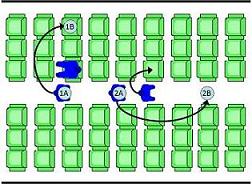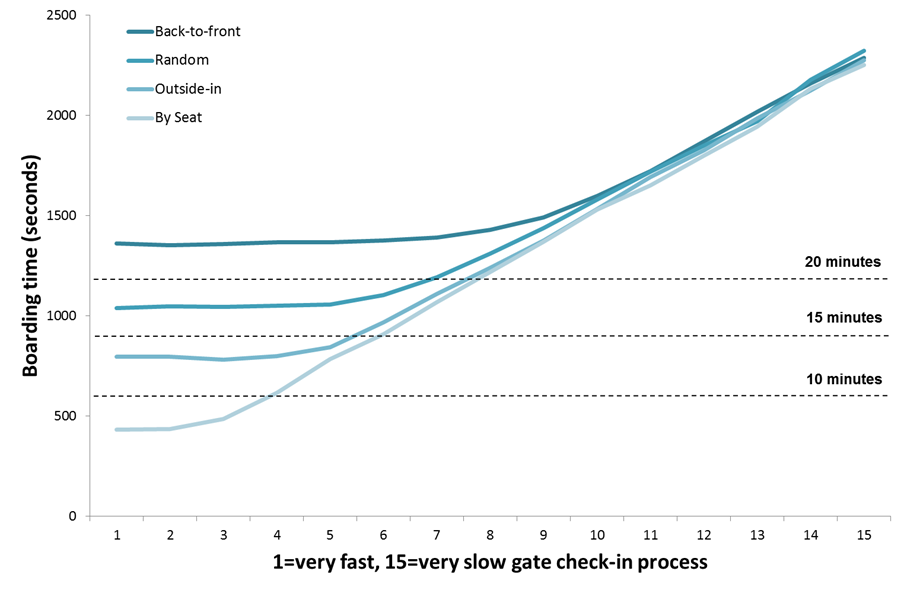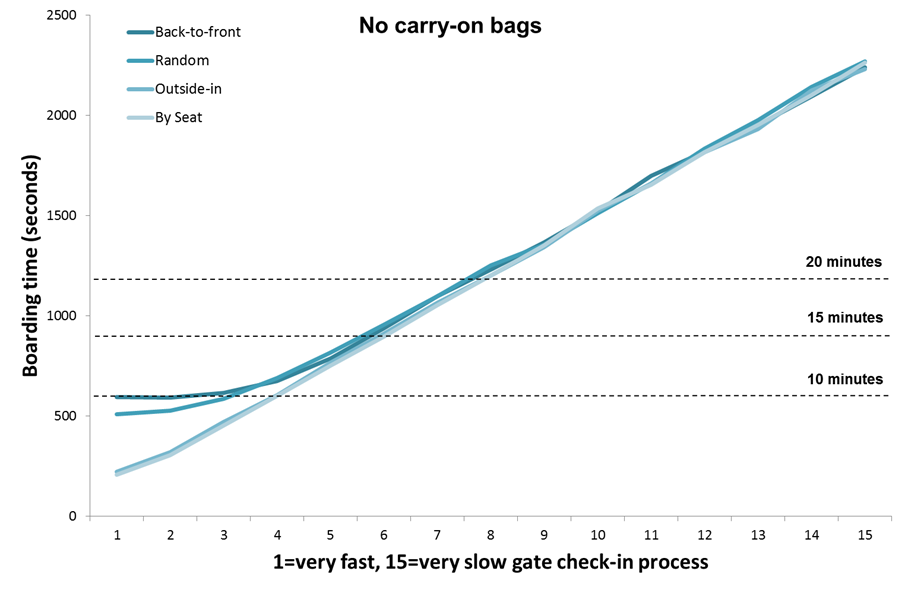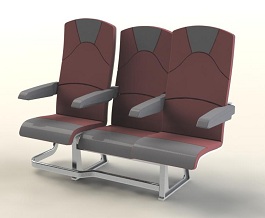Visit my homepage
Group/Zone Boarding
Boarding Systems
Analytical and simulation results show that group/zone boarding can speed up the airplane boarding process. Airlines use a number of different group/zone boarding systems or boarding rules, the idea (there are numerous variations) of some of them, are shown below. By pressing play you can view a simulation of different airplane boarding strategies. Note, random boarding (i.e. boarding all rows at the same time) is faster than back-to-front boarding. Hence, you will actually speed up the boarding process if you board before your turn in back-to-front boarding. Try and explain that to your boarding agent :) See comparison study for a summary of results.
 Back-to-front boarding (contingous rows from the back to the front) |
|
 Random boarding (first class seats then all seats in economy) |
|
 Outside-in boarding (window seats, middle seats, aisle seats) |
|
 By-Seat boarding (board by individual seat) |
Airlines that use them
Several airlines use priority boarding for passengers travelling with small children, first class passengers, business class passengers, frequent flyers, certain card holders, and passengers who check in online. The remainder of the passengers boards using the following boarding systems:
| Back-to-front | Random | Outisde-in | By-Seat |
|---|---|---|---|
|
Air Canada
Alaska
American Airlines British Airways Frontier Spirit Virgin Atlantic |
Jet2 JetBlue |
United Aeromexico |
Comparison Study
Getting from point A to point B
One of the main factors affecting turn time for a commercial airline is passenger boarding time. Reducing boarding time, however, is difficult since it directly involves the passengers. By assigning passengers to groups (or zones) the airline obtains some level of control on the boarding process. Hence, the problem of reducing boarding time can be seen as how to assign passengers to groups (or zones) so that boarding time will be minimized. One way to minimize boarding time is by minimizing the total expected number of seat and aisle interferences.

Seat interference: A passenger (1A) tries to get to a seat near the window (1B) but is obstructed by another passenger already seated near the aisle.
Aisle interference: A passenger (2A) tries to reach his seat further down the aisle (2B) but is obstructed by other passengers trying to find their seats or stow their luggage
Simulation Results


Other ideas for faster boarding
The Sliding Seat by Molon Labe Designs
 |
 |
The Flying Carpet by RoundPeg Innovations
 |
Research
Publications
- A. Steiner, and M. Philipp. 2009. Speeding up the Airplane Boarding Process by Using Pre-Boarding Areas. In Proceedings of the 9th Swiss Transport Research Conference (STRC).
- E. Capelo Junior, J.L. de Castro Silva, M.H.L. van den Briel, and J.R. Villalobos. Aircraft Boarding Fine-Tuning. In Proceedings of the 14th International Conference on Industrial Engineering and Operations Management (ICIEOM-2008).
- M. Schultz, C. Schulz, and H. Fricke. 2008. Efficiency of Aircraft Boarding Procedures (copy on request). In Proceedings of the 3rd International Conference on Research in Air Transportation (ICRAT).
- J. Steffen. Optimal Boarding Method for Airline Passengers (copy on request). 2008. Journal of Air Transport Management. Vol. 14, pp 146-150.
- D.C. Nyquist, K.L. McFadden. A study of the airline boarding problem (copy on request). 2008. Journal of Air Traffic Management. Vol. 14, pp 1997-204.
- M. Bazargan. A Linear Programming Approach for Aircraft Boarding Strategy (copy on request). 2007. European Journal of Operational Research. Vol. 183, pp 394-411.
- E. Bachmat, D. Berend, L. Sapir, S. Skiena, and N. Stolyarov. Analysis of Airplane Boarding via Space-Time Geometry and Random Matrix Theory. 2006. Journal of Physics A: Mathematical and General. Vol 39, pp L453-L459.
- P. Ferrari. 2005. Improving passenger boarding in airplanes using computer simulations. International Airport Review.
- M.H.L. van den Briel, J.R. Villalobos, G.L. Hogg, T. Lindemann, and A. Mulé. 2005. America West Develops Efficient Boarding Strategies (copy on request). Interfaces. Vol. 35, No. 3, pp 191-201.
- M. Pan. 2004. Efficient boarding procedures for midsized passenger aircraft. (highschool graduation project)
- E. Bachmat, D. Berend, L. Sapir, and S. Skiena. 2004. Airplane boarding, polynuclear growth, disk I/O scheduling and space-time geometry.
- F. Pieric, and K. Nagel. 2004. Robustness of Efficient Passenger Boarding in Airplanes.
- M.H.L. van den Briel, J.R. Villalobos, and G.L. Hogg. The Airfcraft Boarding Problem. 2003. In Proceedings of the 12th Industrial Engineering Research Conference (IERC-2003), Nr 2153, CD-ROM.
- H. van Landeghem, and A. Beuselinck. 2002. Reducing Passenger Boarding Times in Airplanes: A Simulation Based Approach (copy on request). European Journal of Operations Research. Vol 142, No 2. pp 294-308.
- S. Marelli, G. Mattocks, and R. Merry. 1998. The Role of Computer Simulation in Reducing Airplane Turn Time. Aero Magazine. No. 1.
People
- Analytic models by Eitan Bachmat and colleagues.
- Simulation studies by Massoud Bazargan.
- Analytic and simulation models by Menkes van den Briel and Rene Villalobos.
- Simulation studies by Emilio Capelo Junior and Jose Lassance de Castro Silva.
- Simluation studies by Pieric Ferrari and Kai Nagel.
- Simluation studies by Hendrik van Landeghem and A. Beuselinck.
- Monte Carlo simulation studies by Jason Steffen.
- Simulation studies by Albert Steiner and Michel Philipp.
In the press
- A. Thorup. Hop pa et flyvende taeppe. Fyens Stiftstidende. December 11, 2010.
- H. Klimpe. Fliegen fur Einsteiger. Financial Times Deutschland. October 1, 2010.
- A. Thorup. Pa flyet i slowmotion. Fyens Stiftstidende. March 20, 2010.
- M. Hosford and K. Barrett. Head in the Sky, Feet at the Gate. ABC News. March 18, 2008.
- It Isn't Rocket Science: How Best to Board a Plane. NPR. March 13, 2008.
- E. Clarke. Physics provides answer to airplane seat scramble. CNN.com International. March 10, 20008.
- M. Ransford. The Key to Better Boarding. March 5, 2008.
- R. McKie. Finally ... how to end plane seat scramble. The Observer. March 2, 2008.
- P. Ball. Strict ordering slashes tarmac time. Nature. February 27, 2008.
- L. Zyga. The Best Way to Board a Plane. PHYSORG.com. February 14, 2008.
- T. Hayden. 10 Ways to Fix Air Travel. Popular Mechanics. January, 2008.
- P.B. Finney. Loading an airliner is rocket science. The New York Times. November 14, 2006.
- B. Longstaff. Let Einstein help you board your plane (subscription required). New Scientist. July 29, 2006.
- J. Randerson. All aboard, with a little help from Einstein. The Guardian. July 27, 2006.
- I. Johnston. Getting passengers in their seats is as easy as E>mc2. The Scotsman. July 27, 2006.
- I. Peterson. Aircraft Boarding by the Numbers. MAA Online. July 26, 2006.
- P. Bernau. Auf die Plätze, Passagiere! Financial Times Deutschland. July 10, 2006.
- G. Stoller. Getting fliers on jets faster. USA TODAY. June 27, 2006
- H. Stil. Instappen in vliegtuigen kan sneller. Het Parool. June 23, 2006.
- Plane Truth: Seating Passengers Is a Pain. NPR. June 21, 2006.
- B.V. Bigelow. No 'cattle car'? Southwest plans S.D. boarding tests. The San Diego Union Tribune. June 21, 2006.
- D. Reed and R. Yu. Northwest tries first-in-line boarding. USA TODAY. June 20, 2006.
- D. Bear and A. Sostek. There's more than one way to fill a plane. Pittsburgh Post-Gazette. June 18, 2006.
- T. Hayden. Now Boarding, Fast. Wired Magazine. June, 2006.
- R. van den Berg. Vliegtuig instappen kan veel efficiënter. NRC Handelsblad . May 11, 2006.
- D. Demerjian. Airlines Try Smarter Boarding. Wired News. May 9, 2006.
- R. Yu. Airlines change how they herd us aboard. USA TODAY. January 9, 2006.
- Wie im Flug -- Reise-Mathematik. Sueddeutsche Zeitung. December 27, 2005.
- Mathematiker weisen schnellsten Weg ins Flugzeug. Hamburger Abendblatt. December 27, 2005.
- T. Horny. Was tun bei Stau an Bord? Focus Online. December 26, 2005.
- D. Millward and R. Highfield. Travellers' scrum fills plane quickly. Daily Telegraph. December 22, 2005.
- A.K. Sommer. Israeli researchers fly by the numbers. December 18, 2005.
- Einsteigen nach dem Chaos-Prinzip. Focus Online. December 15, 2005.
- S. Maier. Express-Boarding mit Köpfchen und Mathematik. Wissenschaft.de. December 14, 2005.
- P. Ball. Warped geometry speeds airline boarding. Nature. December 9, 2005.
- N. Zamiska. Plane Geometry: Scientists Help Speed Boarding of Aircraft (subscription required), Plane Geometry: Scientists Help Speed Boarding of Aircraft (copy). The Wall Street Journal. November 2, 2005
- C. Elliott. How to End Airplane Boarding Bottlenecks. The New York Times. October 18, 2005.
- J. Pilcher. Boarding system works. The Cincinnati Enquirer. January 24, 2004.
- L.E. Hall. ASU engineer designs new boarding system. ASU Insight. May 6, 2003.
- H. Mattern. AmWest hopes new boarding procedure will save time for all involved. The Arizona Republic. May. 1, 2003.